Crypto Academy / Season 3 / Week 8 - Homework Post for professor @yohan2on | Risk Management in Trading
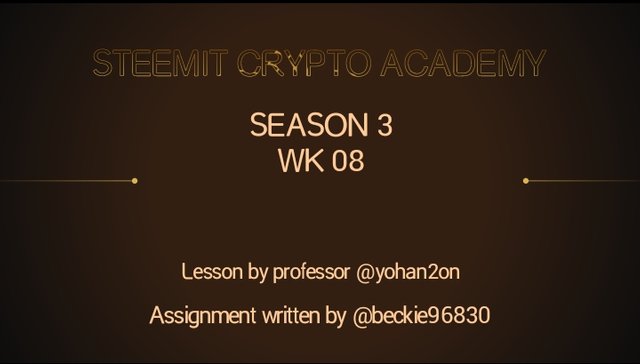
Question 1
Define the following Trading terminologies: Buy stop; Sell stop; Buy limit; Sell limit; Trailing stop loss; Margin call.
Buy Stop
Buy stop order is a type of pending order placed at a determined price above the current price in a traded market. Buy stop trade orders are not executed immediately, they get triggered when the current price moves above the pre-determined buy stop price level.
Buy stop orders are placed in the market in anticipation of a continuation of the bullish movement (price continuing its upward movement). Buy stop orders are sometimes used by experienced Investors to hedge trade positions.
To illustrate this, assuming the current price of Litecoin to US Dollar is 1 LTC ~ $171.76, an investor can place a buy stop order on LTC/USD at $172.95, or at any specified price above the current price after asset spread (difference between asking price and bidding price) is considered.
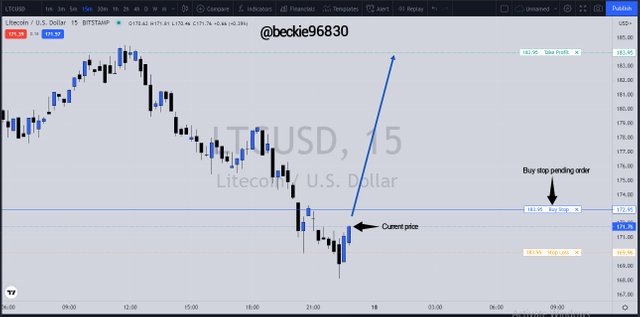
The stoploss and take-profit placement are similar to that of normal buy trade order executed instantly, where the stoploss is below a recent swing low and the Take-profit is above the current market price, set at a minimum ratio of 1:1 RR (Risk to Reward).
Sell Stop
Sell stop order is a type of pending order placed at a determined price below the current in a traded market. Similar to buy stop, the sell stop order is not executed when placed, it is triggered when price moves below the pre-determined price level.
The general market sentiment when placing sell stop orders is bearish, this is in line with the anticipation of the continued bearish movement of price. This type of order is also used in hedging trade positions by experienced investors.
To illustrate, if the current price of Litecoin to US Dollar is $171.25, A pending order can be placed at $167.50, or any determined price below the current price after the spread is accounted for.
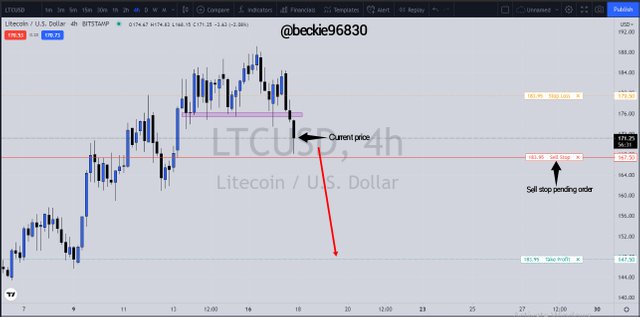
The stoploss and take-profit placement are similar to that of normal sell trade order executed instantly, where the stoploss is above a recent swing higher low and the Take-profit is below the current market price, set at a minimum ratio of 1:1 RR (Risk to Reward).
Buy Limit
Buy Limit is a type of pending order placed at a pre-determined price blow the current price in a traded market. The Buy limit order is not instantly executed, it is triggered when price retraces to the pre-determined levels and continues with its bullish movement.
Buy Limit orders are placed in anticipation that the price of an asset will drop to a specified level before continuing its trend movement. This type of order is used around liquidity areas to join the current trend after a pullback, and also to hedge trade positions mostly done by experienced institutional investors.
To illustrate the placement of buy Limit order, if the current price of Litecoin to US Dollar is $170.32, a Buy Limit order can be placed at $155.50 or any specified price below the current price after spread have been factored in. Buy limits are placed in anticipation of a pullback before trend continuation movement
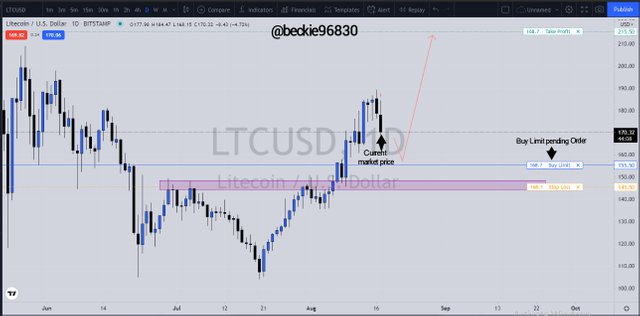
The stoploss and take-profit placement maintain the same placement sequence where the stoploss is placed below an area previously respected by price in anticipation that price will respect the zone and take-profit above the current price.
Sell Limit
Sell limit is a type of pending order placed at a pre-determined price above the current price in a bearish market. Similar to other pending orders, the Sell limit is not instantly executed, rather it is triggered with a pullback in price movement to the pre-determined levels before continuing with the bearish trend.
Similar to Buy Limit, the Sell limit order is placed in anticipation of retrace in the price of an asset upward before continuing the bearish drop movement. Sell limit orders are used by experienced investors to hedge trade positions, and around areas of high liquidity or join the trend movement after a pullback.
To illustrate sell limit order placement, If the current price of Litecoin to US Dollar is $169.57, a sell limit pending order can be placed at $175.50 or any determined price above the current price outside the spread zone, in expectation of a retrace to the sell limit level.
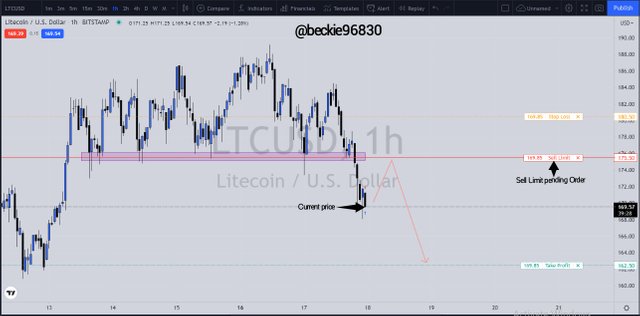
The take-profit and stoploss placement follow the normal sell trade placements, where the take-profit price is placed below the current price and the stoploss is placed above a swing high in anticipation that the level will hold buyers up movement (pullback).
Trailing Stoploss
Trailing Stoploss is a protective measure used by investors to secure profits gained from the directional movement of price without closing the trade position. A trailing stop is calculated in either percent, pip value, or dollar value ratio to the gained profit.
Ideally, A stoploss is placed below or above market price movement in a bullish or bearish market respectively, When price moves in the anticipated direction, investors move their stoploss to a price above or below the trade execution price or order entry price, such that the order can only be stopped in profit. Assuming the trade continues its movement in the intended direction, the trailing stop is moved even closer to the take-profit projected price.
Although sometimes, trailing a stoploss results in early closure of trades because the involved investor trailed the stoploss too early. Trailing stop is best used when price has move at least 50% of the overall trade projection (final TP). This allows fluctuation of price without hitting the stop order. Or when partial profit is secured, the remainder of the trade position can be trailed using the trailing stop.
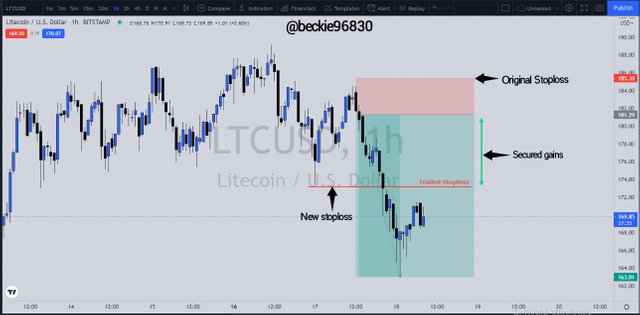
The goal of using trailing stops is to maximize a trade opportunity with minimal risk, through securing gains in anticipation of a continued move.
Margin Call
A margin call is a term used in margin trading (trading with the invested fund and borrowed fund from brokers) to describe when a certain percentage of risk is reached in an account. Brokers that offer margin trading have a pre-determined percentage that the investor's risk can fluctuate within, usually above 100%.
When a margin call occurs, the investor is alerted by the broker to either fund the trading account or close the losing open trade positions. In some traded asset classes like foreign exchange, the brokers automatically close losing positions and deduct the loss from the available balance.
Margin calls should be avoided through the usage of proper risk management. Investors should be risking between 1-3% of the invested capital per trade depending on the investor's experience level, and also avoiding stacking trade positions (opening multiple trades based on one set up seen in one asset). The use of stoploss and take-profit also checkmate margin call in trading accounts.

Question 2
Practically demonstrate your understanding of Risk management in Trading. Briefly talk about Risk management, Use a Moving averages trading strategy on any of the crypto trading charts to demonstrate your understanding of Risk management.
Risk Management
Risk management is considered the most important element of financial trading that involves a set of laid rules developed by investors to protect and manage their invested capital in a financial market. These rules comprise of trading plans (entry and exit strategies), Amount risked per trade, placement of stoploss and take profit price, and a neutral of positive risk to reward.
I will illustrate concept of risk management using a Litecoin US Dollar chart, based on a moving average trading strategy:
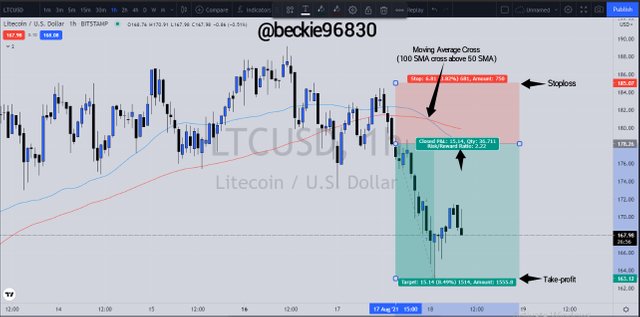
In the LTCUSD chart image above, the following risk management can be followed.
1- Trade plan
Trade plan comprises of rules to follow in executing trade orders, investors twerk trading plans to suit their trading system. In the above chart, the entry plan required the cross of the 100 SMA above the 50 SMA first, to confirm a trading bias, which is a bearish price movement indication. The exit plan was to target the nearest previous low point in accordance with a neutral or positive RR.
2- Risk Percentage
Investors should identify how much they're willing to lose per trade. This percentage calculation is combined with Stoploss price and take profit price to determine the contract size (Lot size) used per trade. The risk percentage also depends on the type of investor and the investor's risk appetite. A high-risk investor usually experienced can risk more than 6-10% per trade, whereas conservative investors generally risk between 1-3% per trade.
Adding numerical analysis to this, let's assume the trade above was taken on a $2,000 account and generally the investor risk 2% per trade:
Balance -$2,000
Risk % - 2%
Amount risked / trade: 2% of $2000 = $40
The investor can risk $40 per trade to either gain $40 or more.
3- Stoploss and Take-profit
Trading with identified and set stoploss and take-profit prices protect the investor from losing more than planned and automatically securing profits gained with the corresponding price is triggered.
Another effective method is trailing stops and securing a partial profit, this helps investors maximize trade opportunities.
4- Risk to Reward
Trading with a positive risk to reward ensures account growth in a situation of a winning trade, where the investor aims to risk a certain amount to gain twice or thrice the amount risked. Some investors trade neutral risk to reward, where the investor aims to make exactly what was risked in the trade.
In the above illustration, the risk to reward was positive in a ratio of 1:2 i.e risking $40 to earn $80. Trailing stops can also be used to maximize a winning position that has the potential to go beyond the take profit price.

Conclusion
Risk management is the most important element to master in the art of financial trading. This encompasses trade guild lines to ensure that the invested capital is exposed to less risk. Having good trading strategies without a risk management system results in deep losses.
Risk management ensures that investors maintain discipline when trading, either in a winning situation or a losing situation by following the risk management plan. The use of trailing stops, stoploss, take-profit prices greatly impacts investors' trading experience.
Thank you professor @yohan2on for this insightful and educative lesson.
Hi @beckie96830
Thanks for participating in the Steemit Crypto Academy
Feedback
Excellently done. Well done with your practical study on Risk management.
Thank you professor @yohan2on I'm indeed happy have attended the lesson.